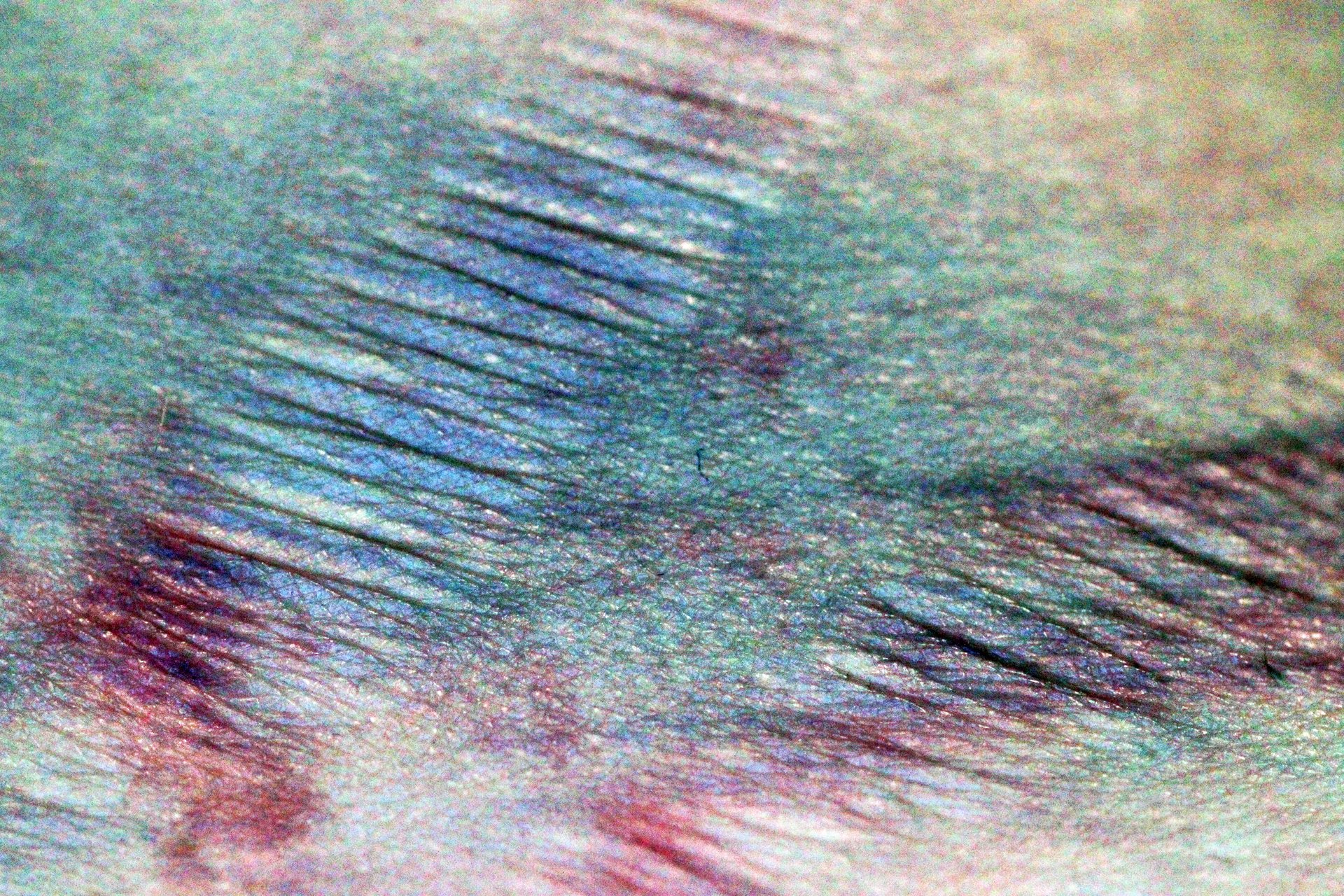
Gabi Sciafani and I have collaborated to bring a new dimension to my work photographing altered states of the skin. In some sense this begins a new, independent project of using macro photography to explore all of the marks we bear. And that’s what I’ve been calling it, Marks We Bear. In another sense, this project is continuous. The colors you see in Gabi’s photographs are not altered from “reality.” They are the effects, unusual to be sure, of the particular lighting I’d arranged. So you might ask if Gabbi’s skin is luminously metallic blue and purple, and I’d be in the clear saying that it is. Gabi herself explains the reality. She begins:
My skin is stretched in certain places – long fingers of striated flesh that wrap around my hip bone, thighs and calves more subtly patterned with horizontal lines. Once angry red, they have faded to mere whispers of what they were. Yet to my touch they are the same as ever, textured silk.
The intensive prednisone treatment I underwent from ages 13 to 14 for a rare autoimmune disease caused my skin to thin, while the related weight gain that typically accompanies long-term high dose prednisone was followed in my case by rapid loss resulting from a comorbid, undiagnosed eating disorder and severe depression. My physician was quick to point out how my eating behaviors had exacerbated the development of stretch marks, making me feel that I had somehow brought them upon myself. He failed to comprehend how paramount my need for control was at a time when I felt that whatever bodily autonomy I once knew had been surrendered to disease and doctors.
Psychology escaping him, he looked at and spoke to me as if I were ignorant, as if I didn’t know that I was destroying my own body, as if I cared enough to stop. He didn’t see my whole being. He didn’t see how weak my spirit was, how in the process of suppressing my immune system he had suppressed me, how my whole self felt beaten into submission.
It wasn’t until the day when three young female residents were following him on rounds, four long months into my treatment, that someone finally inquired about my well-being beyond my body.
“You don’t seem very happy,” one of the women said to me. Perched on the edge of the examination table, hugging tiny arms around tiny shoulders, face red and bloated from the drugs, I burst into tears. I told the residents how I really felt – how I thought I was a burden to the people I loved, how I didn’t really want to keep fighting this. Still failing to meet my eyes, my doctor agreed to refer me to a psychiatrist before whisking his way down the hall.
My mother spent hours calling every pediatric psychiatrist in the state until she found one who would see me. When I met him, it was the first time in months that I felt like a medical professional was actually listening to me. As I adjusted to the meds he prescribed and developed a relationship with a therapist, life slowly grew more bearable. I did not magically become a happy person, but I did stop wishing my life could be over. I regained the ability to speak without stuttering and to look people in the eye, two side effects of prednisone that were particularly painful for me. Under the guidance of a nutritionist, I started gaining weight.
That summer, weaned down to a lower dose of steroids, I started feeling like myself for the first time in my entire life. All throughout my childhood, I had been crippled by anxiety and an extreme sense of empathy. I cried not only for things that hurt me personally, but every time I witnessed injustice or insensitivity. Antidepressants liberated me from the extremity of those feelings, allowing me to experience pain and fear without being dominated by them.
As painful as that time of illness was, in a way it also saved my life. It forced doctors to grant me access to mental health care that I otherwise may never have had, something I believe we all need in a world where violence, systematic oppression, and capitalism reign. In the past eleven years of therapy, I have learned countless tools for accessing and understanding my feelings in ways that do not cripple me, and I have slowly begun to process past trauma.
The knowledge that my disease is likely triggered by stress compelled me to develop self-care practices that continue to serve me. The prayers of my congregation at church galvanized my belief in the power of spiritual community and helped lead me down the path I now travel, as I pursue a Masters of Divinity at Union Theological Seminary.
My stretch marks, which once brought me shame, are now a symbol of power.






